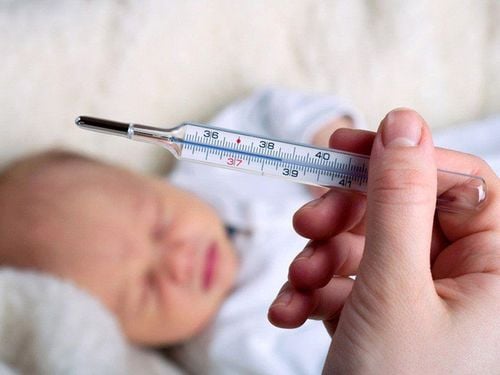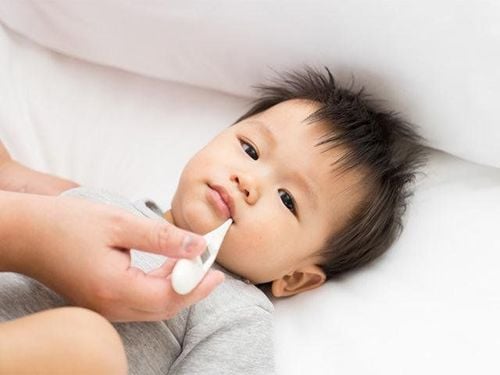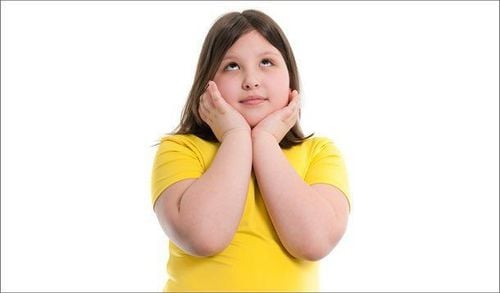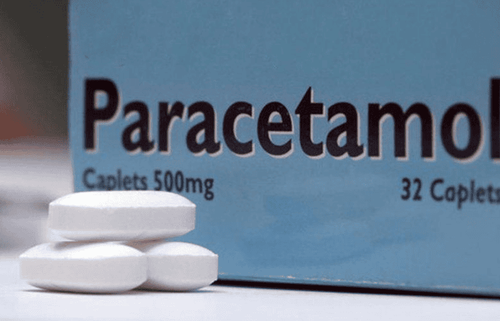This is an automatically translated article.
Persistent fever is a continuous fever, lasting more than 3 days. If a child has a prolonged fever or a persistent fever, it will make the child tired due to dehydration, electrolyte disturbances and may cause convulsions.
1. What is a prolonged fever in children?
1.1. Fever due to viral infection
This is the leading cause of persistent fever in children, the illness usually goes away after 5-7 days, there are many types of viruses that cause illness in children.
Dengue fever: Sudden high fever and continuous fever for 2-7 days; then appear bleeding spots or plaques under the skin, if more severe, accompanied by nosebleeds, bleeding gums, sometimes with internal bleeding. Fever caused by influenza virus: The first sign is usually a blocked nose, then sneezing, dry cough and runny nose; accompanied by fever, the fever is usually mild, with a temperature range of 37.8 - 38 ̊C, in case of superinfection, the child has a high fever, irritability, fussiness, loss of appetite, breastfeeding... Rubella virus fever: Child manifestations persistent fever, low-grade fever, then rash and inflammation of the upper respiratory tract, lymphadenopathy in the occipital region, behind the ears and neck. Fever caused by measles virus: children have a continuous fever, cough, runny nose, red eyes, from the 4th day the rash appears on the face, spreading to the legs and extremities. Fever due to hand - foot - mouth disease: When a child has hand, foot and mouth disease, the child has a prolonged fever, and blisters appear on the soles of the feet, hands, and in the mouth, making it difficult for the child to eat and drink. make children anorexic, fussy, tired a lot. Fever caused by chickenpox virus: At the onset of the disease, children may have persistent symptoms of fever, headache, body aches, then the child's body appears red spots. Water blisters appear first on the face, chest and back and then spread throughout the body. The vesicles initially contain a clear colored fluid but after a day turn cloudy like pustules. After 2-3 days, the acne may crust over. The blisters grow in different waves, so on the same skin area can see many different forms, burning red, clear blisters, cloudy blisters, scaly blisters... Present chickenpox in children and adults It can be prevented with the chickenpox vaccine.
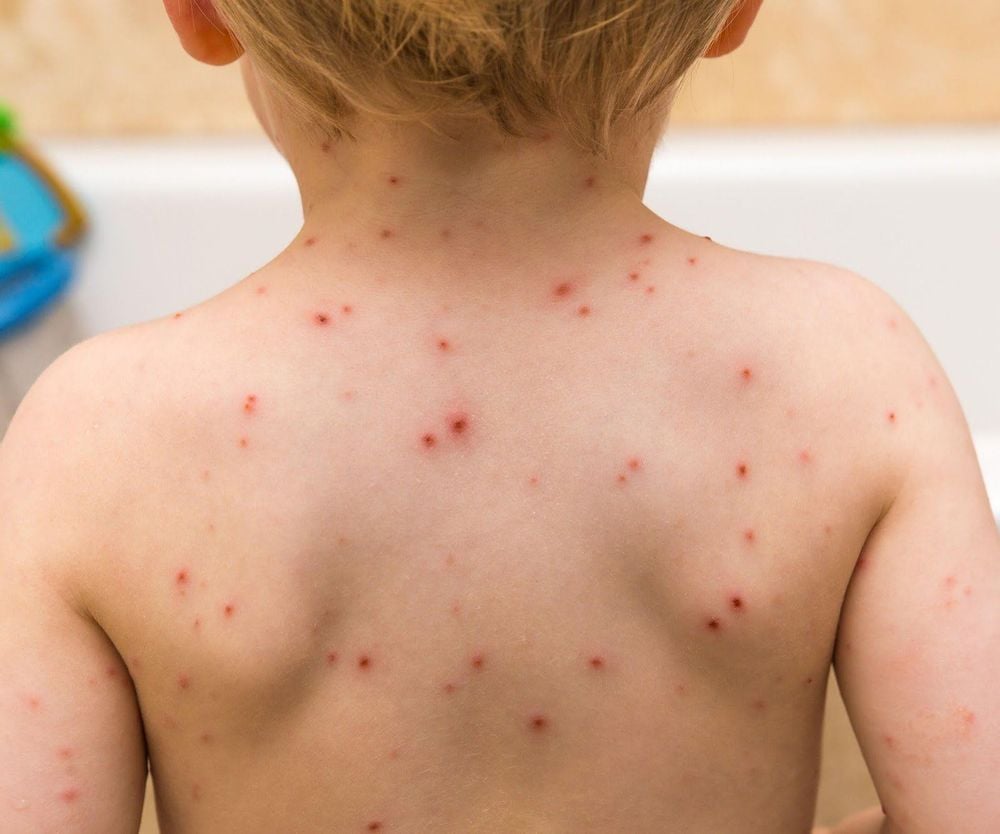
1.2. Children with fever due to bacterial infection
Fever due to pharyngitis - acute tonsillitis: The disease usually has a sudden onset, a high fever of 39-40 ̊C, a prolonged fever, accompanied by painful swallowing, sore throat, hoarseness; fever may be accompanied by other symptoms: runny nose and mucus, soft voice and dry cough, tired children, dry lips, dirty tongue, especially children often appear lymphadenitis in the neck area, swollen angular lymph nodes, pain... With breastfed babies, sore throat is often accompanied by little or no feeding, fussiness. For older children, symptoms of sore throat and loss of appetite make it easy for parents to misunderstand that these are signs of discomfort when the baby is teething. Respiratory tract infections such as tracheobronchitis, pneumonia, pleurisy, lung abscess, children often have fever, cough, sputum or blood, chest pain, difficulty breathing... Urinary tract infections : Cystitis, pyelonephritis, acute glomerulonephritis, children have fever with painful urination - frequent urination, little urine, cloudy or pink urine, edema, low back pain. Infections of the hepatobiliary tract: Children often have high fever, continuous prolonged fever accompanied by jaundice, yellow eyes, liver pain. Meningococcal infection: Children have a continuous fever with a lot of headaches, vomiting, may have convulsions, hemiplegia or coma. In young children, fever is often accompanied by a bulging fontanelle, stiff neck, inability to move the neck, inability to lower the head, sensitivity to light, vomiting, lethargy. Blood infection: The child shows signs of infection, continuous fever, inability to eat and drink, vomiting all, lethargy, rapid pulse, rapid breathing, possible skin rash...
1.3. Some other reasons
Fever caused by malaria parasites: Children often have a history of living or traveling in malaria-endemic areas, malaria in children often has less typical malaria than adults such as: chills, high fever, sweating , which, in children, usually has a fever of continuous duration, with or without chills, sometimes just chills, fatigue, headache, muscle aches. Number due to typhoid: Children often have high fever, fever lasting more than 5 days, abdominal pain, abdominal distension, vomiting, diarrhea or constipation. Tuberculosis fever: Children often have signs of persistent fever, often low-grade fever in the afternoon, night sweats, loss of appetite, weight loss or weight loss, cough profusely, coughing up blood and not responding to common antibiotics. often.
Trắc nghiệm: Nhận biết sớm dấu hiệu chậm phát triển thể chất và trí tuệ ở trẻ
Nếu 6 tuổi không biết đếm số, 7 tuổi vẫn chưa phân biệt được giữa thực tế và tưởng tượng thì có thể bé chậm phát triển thể chất và trí tuệ hơn so với bạn bè cùng lứa. Bạn đã nhận biết được các dấu hiệu bất thường sớm này chưa? Cùng làm nhanh bài trắc nghiệm sau để trang bị thêm kiến thức cho mình nhé!
The following content is prepared under supervision of Thạc sĩ, Bác sĩ y khoa, Ma Văn Thấm , Nhi , Phòng khám Đa khoa Quốc tế Vinmec Dương Đông(Phú Quốc)
2. How should fever be treated?
Let the child lie in a well-ventilated place, limit many people around the child. Thermocouple for children (the thermometer can be placed under the armpit or in the anus of the child). The thermometer should be kept in the child's armpit for a minimum of 3 minutes, with the child's arm close to the chest. The baby's actual temperature will be the number shown on the thermometer plus about 0.3 - 0.4 degrees. For example, if a thermometer reads 38°C, the baby's actual body temperature is about 38.3 - 38.4°C. If the child's temperature does not exceed 38°C: remove clothes, do not cover, wear only light clothes for the child and monitor the child's temperature regularly, measuring once every 1 hour. If the child's temperature is around 38 - 38.5°C, the child's fever can be reduced by the following methods: removing some clothes, using physical methods to reduce fever (warm up and wipe the child's body) and reduce fever. with common antipyretics. The application method is to use a clean, soft cotton towel, dip it in a basin of water, wring it out, then wipe it all over the child's body, especially in areas such as armpits, groin, wait for evaporation, then continue wiping until the body temperature drops about approx. 37.5°C. If the child's temperature is 38.5°C or higher: It is necessary to give the child paracetamol fever-reducing medicine according to the correct dose, weight and interval between two doses stated in the instructions for use. If the child is nauseous and can't take the medicine, it can be used as an rectal medicine. Give your child plenty of fluids, especially fresh fruit juices. It is necessary to take the child to the nearest medical facility for examination to determine the cause and treatment of the fever. Cases that need to be taken to a medical facility: child has a fever that lasts more than 3 days, a fever lasts continuously without taking medicine to reduce fever, fever is too high, 40-41 ̊C (just give medicine and give it away). immediate hospital) fever, taking medicine but having allergies, fever accompanied by danger signs such as lethargy, vomiting, not eating, not playing, lethargy, difficulty waking, convulsions, rapid breathing, difficulty breathing, Abnormal breathing, diarrhea, bloody stools, persistent fever, infants ≤ 2 months old.
In particular, it should be noted that do not use the drug if the child has allergic manifestations, do not use the drug with children with a history of hepatitis, jaundice due to biliary obstruction. In these cases, it is forbidden to use the drug at home. At that time, the child has a prolonged fever, must be taken to the hospital and treated under the guidance of the doctor.
Vaccination for children is the most effective and economical method to prevent diseases affecting children's health.
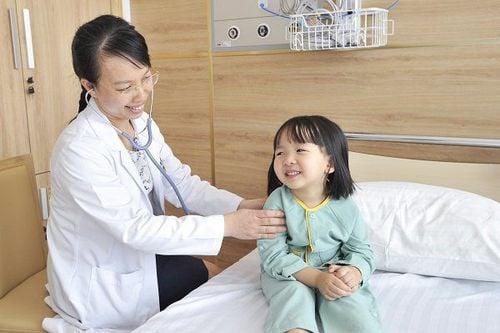
With a team of experienced and dedicated doctors from the leading pediatric hospitals in Vietnam, the Pediatric Center at Vinmec International General Hospital is trusted by parents in the treatment of respiratory and tropical infections. children in general and treatment of children with prolonged fever in particular.
Profs.Ts. Bs. Pham Nhat An - Director of Pediatrics Center and Head of Pediatric Inpatient Department, Vinmec Times City International Hospital, 40 years of experience in the industry, and general secretary of the Vietnam Pediatric Association. Master - Doctor Mai Kieu Anh - Deputy Pediatric Inpatient Department - Head of Pediatric Resuscitation Unit, Vinmec Times City International Hospital, with nearly 10 years of working experience in Pediatric Emergency Resuscitation. Master, Doctor Nguyen Thanh Hung - Head of Pediatrics - Neonatology Department - Pediatrics - Neonatology Department - Vinmec Nha Trang International General Hospital, with many years working in the field of General Pediatrics and Neonatology. Specialist II Tran Thi Linh Chi - Head of Department of Pediatrics - Neonatology - Department of Pediatrics - Neonatology - Vinmec Hai Phong International General Hospital, Doctor has worked in pediatrics for more than 15 years, has a long time Head of Functional Exploration Department, Head of Cardiology and Thoracic Department, Hai Phong Children's Hospital, With the strength in proficiently performing pediatric and neonatal resuscitation techniques, the doctor has treated more than 1000 cases of premature babies and more than 1000 cases of neonatal diseases such as severe neonatal jaundice. , neonatal respiratory failure,... Associate Professor, Doctor, Doctor Nguyen Thi Hoan - Head of Pediatric Outpatient Department - Pediatric Center - Vinmec Times City International Hospital, Doctor Hoan has 40 years experience in pediatrics and is a leading doctor specializing in pediatric endocrinology in Vietnam Associate Professor, Doctor, Doctor Huynh Thoai Loan - Head of Pediatrics - Neonatology - Pediatrics - Neonatology Department, National General Hospital At Vinmec Central Park, Dr. Loan has nearly 30 years of experience in examining and treating pediatric endocrinology, pediatric kidney and pediatric - neonatal problems In addition, there are many doctors in the Vinmec health system. Pediatrician, experienced and specialized, has performed surgery and emergency treatment of many difficult cases. Especially, now to improve service quality, Vinmec continues to equip modern medical machinery with negative pressure room with one-way ventilation to help isolate patients well, limit cross-infection between hospitals. surrounding patients, reducing the hospital stay for the child to less than 4 days. Therefore, parents can rest assured with the medical examination and treatment process at Vinmec.
Please dial HOTLINE for more information or register for an appointment HERE. Download MyVinmec app to make appointments faster and to manage your bookings easily.





